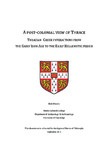Dimova, Bela
Abstract
The way we see relations between ‘Greeks’ and ‘Barbarians’ in the 1st millennium BC Mediterranean has changed dramatically over the past 20 years. Under the influence of post-colonial theory, the narrative has shifted from colonial conquest to multiple histories of diverse encounters. This thesis examines the case of ancient Thrace: an under-explored region, which offers a unique perspective on Greek-Non-Greek relations. Geography endows Thrace with a long-lived history of interactions with Greece and very different possibilities for connectivity, compared to the Mediterranean. The aim of this thesis is to explore what forms interactions between communities in Thrace and Greece took in different geographical settings, and how they changed over the 1st millennium BC. I trace how indigenous people adopted and used imported objects and technologies in different social contexts in Thrace. This enquiry sheds light on the indigenous perspective, which has been often left off the pages of history. The evidence is synthesised and discussed in three core chapters. Chapter II takes a regional-wide and long-term perspective. I review the settlement dynamics, burial and religious practices across Thrace through the Iron Age, and I examine the place of imports in each of these spheres. Chapters III and IV focus on two contact-zone cities: Apollonia on the Black Sea, and Adzhiiska Vodenitsa on River Hebros, near modern Vetren. At Apollonia – a classic example of a coastal Greek colony, we can follow how a community of diverse origins constructed a unified community identity as a Pontic Ionian city. Apollonia’s trade and diplomatic relations with neighbouring communities started from its establishment and unfolded prosperously. Vetren is also considered a colony – a Thasian emporion – but after re-assessing the epigraphic, historical, and archaeological evidence, I argue that this identification is unconvincing. The site is better understood as a market town with a mixed population, under Thracian authority. Vetren therefore invites us to rethink the rise of indigenous urbanism, and particularly the role of imports in the constitution of early towns and urban economies. The two case studies and the regional review recuperate some of the diverse interactions between Thrace and Greece, including technological transfer, trade, migration, and elite contacts, among others. They offer a perspective on how aspects of Thracian society changed through cultural contact, on indigenous terms: by embracing and adapting some elements (coinage, wheel-made pottery), and showing limited interest in others (e.g. writing). In the processes of cultural contact and social change, people manipulated the boundaries of identity and alterity in more complex and historically meaningful ways than the binary classification of Greek and Thracian allows: by creating idiosyncratic local identities such as the Pontic Ionians at Apollonia; or by living an urban lifestyle, which had more in common with urban centres of the Aegean, than other Thracian settlements, as at Vetren.Keywords
iron age, Thrace, GreeceIdentifiers
This record's DOI: https://doi.org/10.17863/CAM.60155
Date
2015Awarding Institution
University of CambridgeQualification
PhDLanguage
EnglishType
Thesis










 Stumble It!
Stumble It!

No comments:
Post a Comment